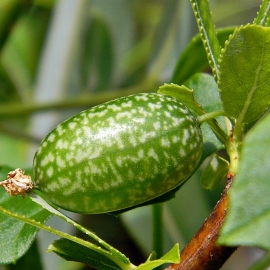 EXCLUSIVE
EXCLUSIVE




Organic melotria droop Seeds (Melothria pendula)
3.00 €
Perennial climbing herbaceous vine from the pumpkin family, cultivated for the sake of small edible fruits that taste like cucumbers, does not form tubers, therefore it easily takes root by shoots.
-
Drop Melotria / Melothria pendula
Perennial climbing herbaceous vine from the genus Melotria of the Pumpkin family. It comes from the tropical forests of equatorial Africa and is sometimes cultivated for its small edible fruits that taste like cucumbers.
Melotria propagates by seeds, which are planted in the usual way to obtain seedlings, which are poured into boxes with a nutrient mixture in the first half of April. The seeds are very small, so it is better not to sprinkle them with earth, you just need to cover the surface with a film. Seedlings appear quickly, after two to three days. When the third true leaf is formed, the seedlings are transplanted into separate pots, two to three seedlings each. Seedlings are regularly watered, however, avoiding waterlogging. In mid-May, seedlings can be planted in a permanent place, in light fertile soil.
Melotria needs quite a lot of sunlight, although it can tolerate a little shade. If the purpose of planting is to create vertical gardening, then at the beginning of the growing season the plant must be fed with nitrogen - then the greenery will be more lush. But to get more fruits, it is necessary to feed with complex fertilizers with a predominance of phosphorus and potassium.
Melotria is an excellent addition to the already known culinary recipes, especially appreciated by vegeranian chefs. Fresh melotria fruits are added to salads, used as a decoration for various dishes, they are pickled in pickles and salted in dill brine like cucumbers. Finely chopped mouse melons are added to salsa - they say that they give the dish a unique zest.
The main difference between melotria drooping and melotria rough is that melotria drooping lacks root tubers, and it is prone to the formation of long horizontal shoots that easily root when in contact with moist soil. Aggressive shoots of the plant quickly occupy a large area. Such shoots must either be raised on a support in time to form a beautiful green trellis, or ruthlessly removed.
